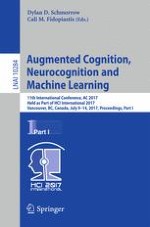2017 | OriginalPaper | Buchkapitel
A Comparison of an Attention Acknowledgement Measure and Eye Tracking: Application of the as Low as Reasonable Assessment (ALARA) Discount Usability Principle for Control System Studies
verfasst von : Thomas A. Ulrich, Ronald L. Boring, Steffen Werner, Roger Lew
Erschienen in: Augmented Cognition. Neurocognition and Machine Learning
Aktivieren Sie unsere intelligente Suche, um passende Fachinhalte oder Patente zu finden.
Wählen Sie Textabschnitte aus um mit Künstlicher Intelligenz passenden Patente zu finden. powered by
Markieren Sie Textabschnitte, um KI-gestützt weitere passende Inhalte zu finden. powered by
